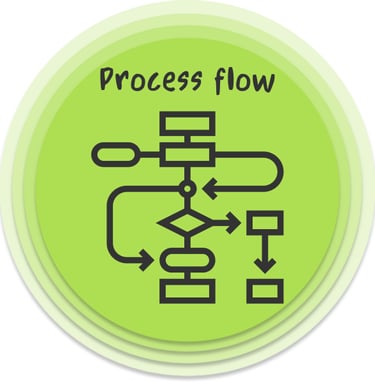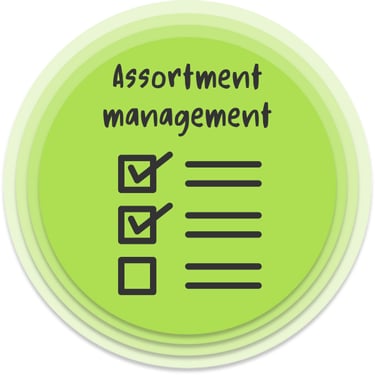Process management: how does it affect inventory management?
Table of Contents
Every organization operates through a series of interconnected processes to achieve one primary goal: profitability.
By managing processes effectively, companies become more efficient and achieve greater success. During periods of growth, great importance was placed on process management, and many companies hired consultants and integrated structured processes into their operations.
However, process management was sometimes dismissed as a bureaucratic formality, and some efforts resulted in unused documents or unrealized strategies. Despite this perception, the role of process management in increasing company efficiency and its significant impact on inventory management remains undeniable.
What is process management?
Process management involves defining, organizing, and improving workflows to help a business operate efficiently. It breaks tasks into manageable steps that can be completed effectively while staying aligned with the company’s goals. The aim is to create order and consistency in daily operations, eliminate inefficiencies, and improve overall performance. From inventory and production to customer order management, process management ensures activities run smoothly, optimizes resource use, minimizes risks and errors, and supports overall business success.
Why does process management matter to inventory management?
Inventory management is not just about moving products in and out of the warehouse. It is a set of processes to ensure that the right quantity of goods is available at the right time and place. When a company operates without standardized processes, it usually faces the following problems:
Stockouts: products are unavailable when needed, resulting in customer orders not being fulfilled on time.
Excess inventory: excess inventory ties up capital and increases storage expenses, straining cash flow.
Inefficient use of transport: poor planning results in partially loaded shipments, driving up transportation costs unnecessarily.
Clear and standardized processes provide the structure and reliability that are needed to manage inventory effectively and help businesses avoid these common issues.
What do inventory management processes involve?
Tracking stock levels is an important part of inventory management, but several processes take place both before and after. These include calculating order requirements, managing product assortments, and making informed decisions about when and how to replenish stock. These processes ensure that inventory aligns with business objectives and meets customer needs effectively.


1. Order calculation and product needs
A structured approach to replenishment helps prevent issues like overstocking or stockouts. Key questions to consider include:
How frequently should orders be placed?
What is the optimal order quantity, considering current demand, supply lead times, and order frequency?
What actions should be taken if the planned order size doesn’t fill a transport container?
Clear rules are important for managing situations like partially filled shipments. For instance, should an order be delayed until sufficient demand accumulates, or should smaller shipments be sent despite higher costs?
These decisions require close collaboration among procurement, sales, and planning teams to achieve a balance between operational efficiency and cost management.


2. Assortment management
Assortment management directly affects the efficiency of inventory management. Well-organized inventory management processes can provide transparency and help you make decisions. Key areas to be assessed include:
Prioritizing items: identify fast and slow-moving items to prioritize storage and allocate resources efficiently.
Product Recall: determining which products should be recalled based on current demand and profitability trends. This process typically involves withdrawing inventory, suspending new orders, and removing the product from active inventory.
New product launch: determine how to integrate new products into warehouse and inventory management systems and distribute them to customers.
Rules for assortment management eliminate spontaneity and uncertainty. For example, after the introduction of a new product, there is often an adjustment period during which sales may be lost or excess inventory may occur. When such a situation is process-based, it is not called good or bad, it is simply part of the assessment management process.


3. Clarification of decision-making roles
Inventory management is not solely the responsibility of the inventory manager as it involves much more, so decision-makers also go beyond the inventory manager. How well inventory is managed and how satisfied customers are determines how much a company makes. Key roles typically include:
Procurement teams determine when and what to reorder based on delivery lead times and inventory data.
Sales or operations teams provide insight into current customer needs and match inventory to demand.
Managers who oversee processes to ensure inventory aligns with broader business goals.
Defined roles let companies avoid confusion and ensure smooth coordination between departments, improving inventory efficiency.
Inventory management and decision-making processes give structure to inventory operations and help companies meet customer demands while minimizing costs and inefficiencies. This process approach allows companies to respond more flexibly to changing needs and maintain a balanced inventory system.


Transportation constraints
A common problem in inventory management is balancing order volumes with transportation efficiency. For example, what happens when an order doesn't fill the entire truck? Companies need clear processes to guide such scenarios:
Prioritize products: decide which items to prioritize based on urgency or profitability.
Consolidate orders: determine whether it is possible to wait for the truck to be filled with additional items.
Split shipments: if partial orders are necessary, establish criteria for splitting loads while minimizing additional costs.
These decisions should be based on predefined principles rather than ad hoc judgments to ensure consistency and control costs.
How to build strong processes?
Building, implementing, and improving inventory-related processes requires a step-by-step approach:
Audit current workflows: map out every process, from a decision to enter new items, and receiving goods to deciding to reorder quantities or discontinue products. Identify pain points or inefficiencies.
Standardize procedures: create clear, written instructions for handling different already known situations, such as transport underutilization or sudden demand spikes.
Use metrics to monitor performance: track metrics like order accuracy, cycle count discrepancies, and transport utilization to measure process effectiveness.
Train employees: ensure all team members understand their roles and responsibilities within the processes.
Leverage technology wisely: use systems to automate repetitive tasks, but ensure that processes guide how technology is applied.
StockM's team of inventory management experts has extensive experience working with companies of different industries and sizes. Their focus is to implement transparent and efficient inventory processes. The team automated the most common and important workflows and integrated them into the inventory management platform. This approach simplifies employee inventory, ordering, and assortment tasks, enabling them to work more efficiently and supporting the company's overall success.
fluentSTOCK was developed specifically for small and medium-sized businesses by the StockM team. It integrates the core principles of effective inventory management along with automated inventory management processes.
If you have any questions about fluentSTOCK functionality, please contact us to discuss further.


